Home » Other Articles » Tuesday Treasures Index » Tuesday Treasures - January 2024 - Tuesday Treasures - January 2024
Tuesday Treasures - January 2024
TUESDAY 30 JANUARY
Railway Dogs
Among the huge archive of Great Western Railway material donated to the Great Western Trust by the late Ron King Bird is this cutting from the Picture Post of 15 July 1939, describing the railway’s use of dogs to keep the Welsh valley lines clear of sheep.
The dogs first came to peoples’ attention when the Great Western Railway Magazine published an article about them in the February 1937 edition. The Times newspaper took up the story in its edition on 3 February that year. Picture Post, which was published from 1938 to 1957 gained an enviable reputation for its photojournalism. We hope you enjoy this revival of the pictures and words below, from the article:
A few weeks ago, a train going to Flint was held up for three-quarters of an hour by a sheep. The animal·had wandered on to the line, and, regardless of rights of way, by-laws and time tables, remained grazing right in front of the engine. The fireman got down and shoo-ed it. The driver got down, too. Then the guard joined in. The sheep took refuge between the carriages, played hide-and-seek with its pursuers, and refused to return to its field.
At last, help was got from a neighbouring station and the train proceeded on its journey.
At one time, this was a regular procedure on Welsh valley lines. Today, it happens only occasionally.
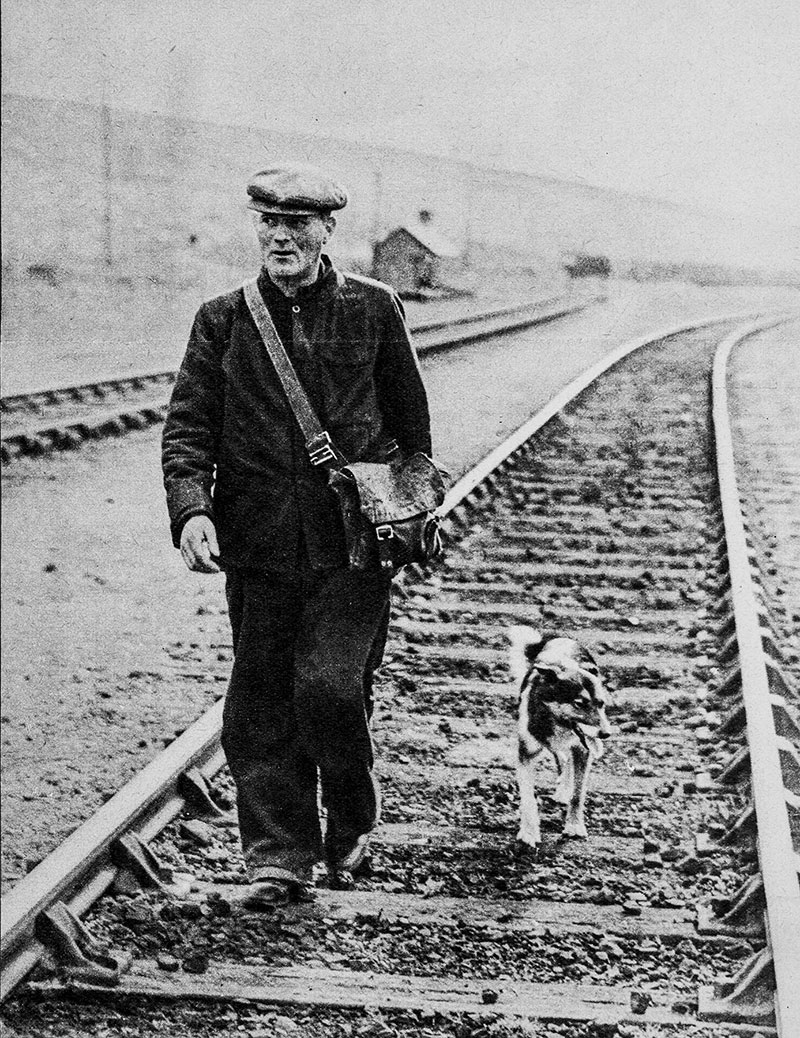
A Railway Dog Patrols the Line with His Master - ‘Toss’ is one of twenty-five railway dogs employed by the Great Western Railway to clear the South Wales valley lines of sheep. With his master, Ganger William Evans, he patrols several miles of line every day. He has been trained to know a train’s warning whistle, to obey his master’s word – in English or Welsh – and to answer hand signals
The Great Western Railway employ 25 dogs to keep their lines clear of ‘sheep menace’. The valley lines of Cardiff, Neath, Newport and Oswestry are patrolled regularly. As it is a ganger’s job to patrol his stretch of line at least once a day, so it is the sheep dog’s job, too. The GWR pay their licences, but the dogs usually belong to the gangers, are trained by them, and go with them on duty.
They have a method all their own. Long before the sheep are visible on the track, the dogs know they are there. Racing·ahead of their masters, they approach cautiously until they are close to their quarry, then they charge with loud and vicious barking. Down the track they go, chasing the sheep ahead of them. The track at that point may lie in a cutting, or it may be bound by close hedges. It makes no difference.
The dog chases the sheep until an opening appears, through which it can be manoeuvred to safety.

What the Railway Dog is Looking For: Sheep on the Line Causing Delay and Danger - In the South Wales valleys, the old tale of a cow on the line has a grain of truth in it. Only they’re sheep in this case. For years, sheep on the line, especially at night, have been a danger to trains. Even when they weren’t a danger they caused troublesome delays. So the Great Western Railway instituted a system of railway dogs, trained to keep the trackside clear of sheep. That was 25 years ago. Today the dogs are still a novelty. They are only canine railway employees in the country
The public hear a good deal of the intelligence of sheepdogs. They have sheepdog trials all over the country and even in Hyde Park. But nobody would ever think of holding railway dog trials, although a railway dog’s life is just as onerous, and requires just as much intelligence. Nor do railway dogs enter shows. For one thing, they do not usually sport a pedigree – collie predominates, but other breeds are evident as well. And a railway dog has no time for titivating itself. Life for him is just one round of business.
It’s not just the sheep he feels himself responsible for. It’s the human beings, too. You can understand sheep wandering on to the track and getting engrossed in a tuft of grass they find there. But for human beings to stay on the line tapping away at a bolt when the express from Cardiff is only half a mile away is beyond canine comprehension. If a railway dog has ‘track sense’ why hasn’t a human being? The fact remains that a railway dog will warn a ganger of an approaching train, will bark at him and worry him until he moves, and will not leave him until he is well away to safety.
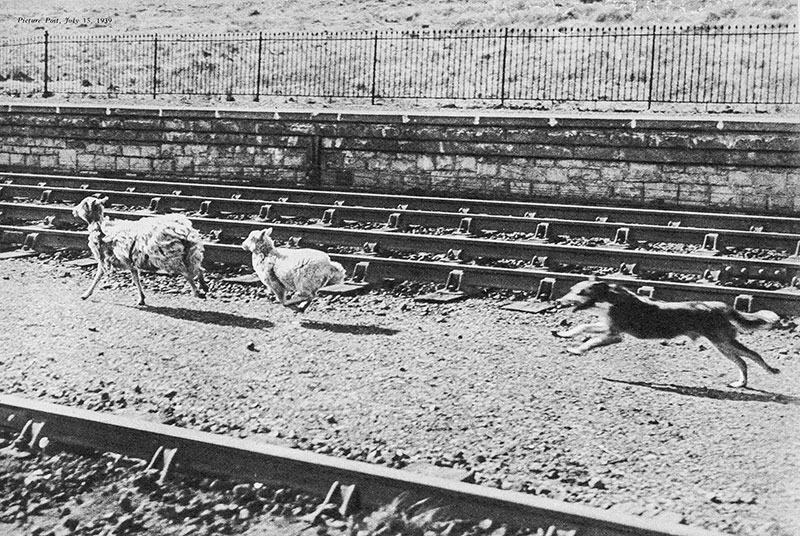
A Railway Dog in Action: Clearing the Line for the Cardiff Express - ‘Toss’ has got the trespassers on the run. He manoeuvres them into the broad road between the tracks and keeps them there. It’s safer when he has a good way to go. Just here the wall is long and there are railings – but there’s a hedge beyond, and a gap into the field. If the train overtakes ‘Toss’ he will simply lie quiet until it has passed
Often in sticking to his post until the last minute a dog finds himself in danger – sometimes when two trains are approaching in opposite directions. In which case, he lies down between the sets of lines until the two trains have passed.
Training begins when a dog is about six months old and goes on until he is about two. If he isn’t trained by then, he ought to be. His master keeps him continually by his side during the period of training. No one else feeds the dog. Even a casual pat is not much encouraged.
The dog is taught to know the warning whistle of an approaching train, to answer verbal commands, sometimes given in Welsh, and whistles and hand signals of his master from a considerable distance. As the dog gets used to the work he comes to be less dependent on his master. He hears a train coming long before the man. If he sees sheep on the line he goes after them of his own accord. He barks to give warning to men working. Often he routs trespassers long before the ganger's arrival Many dogs have put in ten years of good and faithful service.
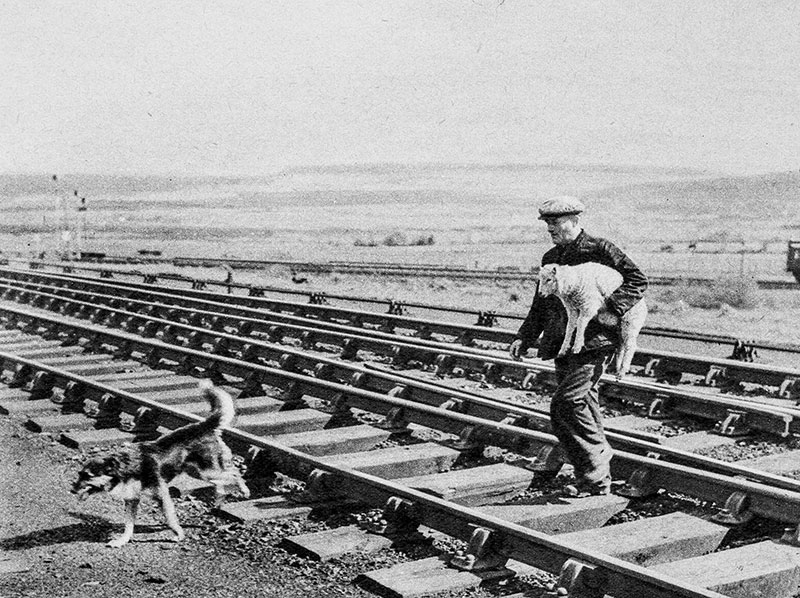
The Lamb That Got Left Behind - The chase was too much for this young lamb. So the ganger saved it. Carried it off the track to safety
The dog’s busiest time is between mid-May and July, when a large part of the four and a half million sheep in Wales are driven for washing and shearing. Then, in September comes the drive for the compulsory dipping. In some districts, too, in October, the sheep are brought down from the mountains to winter in the warmer climate of the lowlands.
The system of railway dogs has been going on for over twenty-five years. It was the first of its kind, and it remains the only one. Nowhere else do dogs figure on the payroll of a big railway company as guardians of the public safety.
TUESDAY 23 JANUARY
A Simple Blueprint Opens Up Great War Ambulance Train History
During the Great War, ambulance trains for use in Northern France and Belgium were built by a number of the major railway companies. The Great Western Railway re-equipped 238 vehicles and as a matter of necessity each of the companies exchanged drawings in order to ensure compatibility.
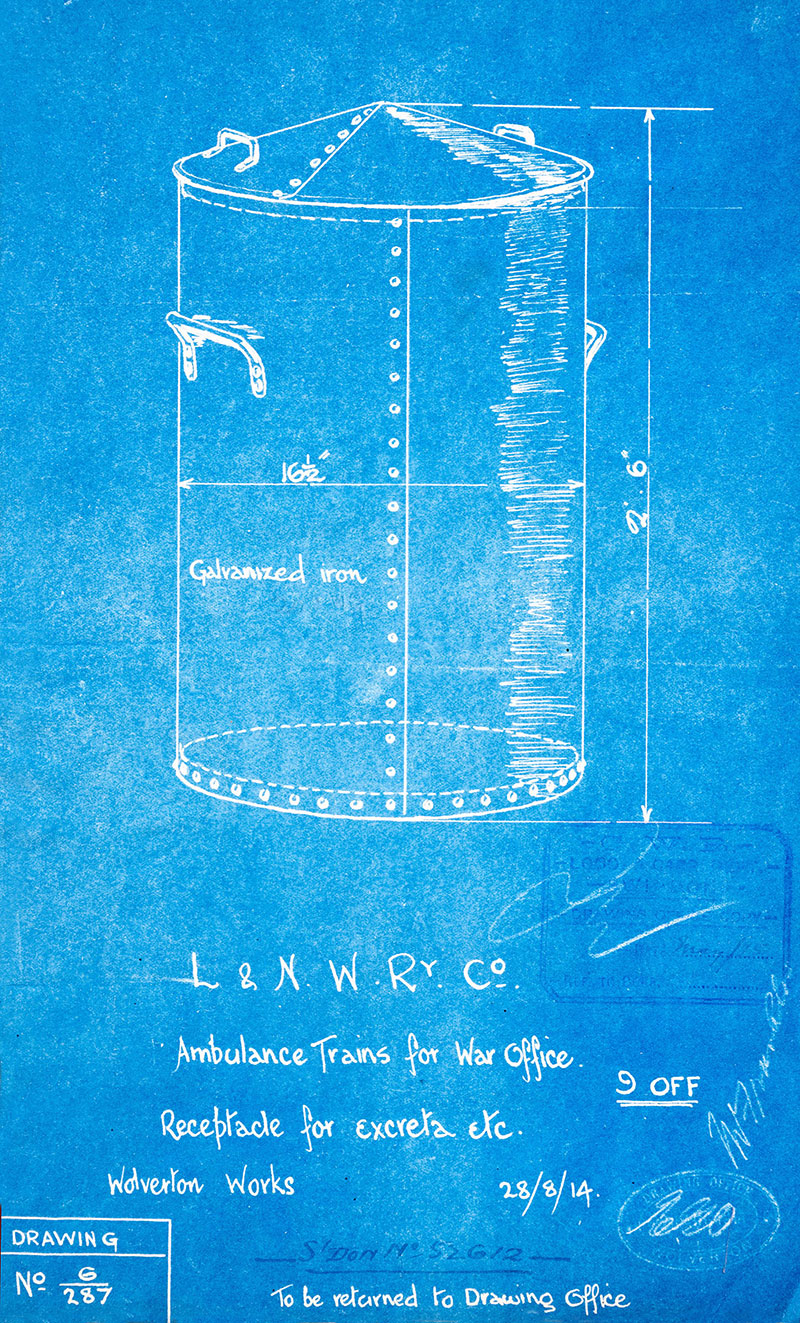
Blueprint of the galvanised iron container designed at Wolverton for Ambulance Trains. The drawing is now in the Great Western Trust collection
This fascinating drawing, although originating from Wolverton Works of the London & North Western Railway is stamped ‘GWR Loco & Carr Dept. Swindon’ and is dated May 1915. It is one of a number of Ambulance Train drawings which demonstrate the extent of practical provision which had to be made to care for dreadfully injured soldiers.
This ‘Receptacle for excreta etc’ is a substantial item, made of galvanised iron, and must have been extremely difficult, not to say unpleasant to move, containing some eighty litres when full. Pity the poor souls whose job it was to empty and clean it.

The first Ambulance Train supplied by the GWR, in August 1914. Passenger brake vans, like No 933 preserved at Didcot, were converted into ward cars. Photograph published in the Great Western Railway Magazine, October 1914
One school of thought is that, having detached the handles, it could have been fired at the enemy trenches thus lowering enemy morale more effectively than conventional artillery!
While on the subject of Ambulance Trains we must never forget the role of the nurses who staffed them. Not only did they also risk life and limb but also fought against the resistance of a male establishment. They were as heroic as those who fought in the trenches.

A composite of photographs of the GWR’s first Ambulance Train supplied in August 1914. Photographs published in the Great Western Railway Magazine, October 1914
Three nursing sisters, Kate Mahony, Ethel Thompson and Mabel Evans were each awarded the Military Medal after a bombing rain on No 27 Ambulance Train, provided by the GWR, during the night of 10-11 November 1916. An amendment to the Royal Warrant on 21 June 1916 had allowed, for the first time, the award of the Military Medal to women.
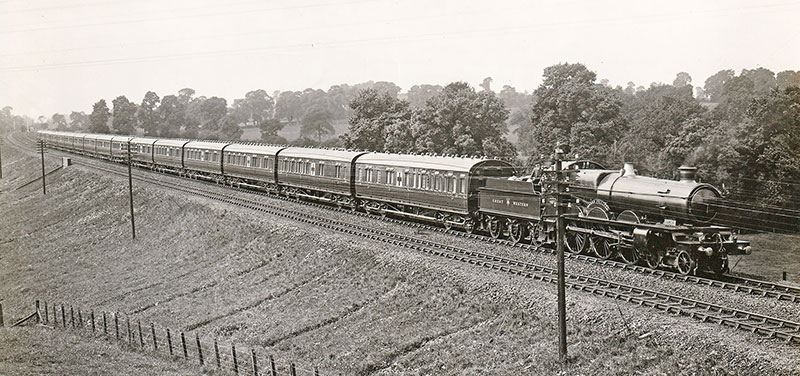
Ambulance Train No 18 supplied by the GWR in August 1915, with Star class No 4037 Queen Philippa at the head. A GWR publicity photograph in the Great Western Trust collection
Of the events that night of 10-11 the Officer Commanding No 27 Ambulance Train wrote:
I desire to draw attention to the courage and coolness shown by Sister M L Evans TFNS, Sister K Mahoney QAIMNSR, Sister E K Thompson QAIMNSR. We were carrying down a full load of sick and wounded (450) and our arrival at Amiens coincided with the beginning of an aeroplane attack. All ‘stood to’ – electric lights were switched off and hand lamps lit etc. We ran on until halted outside the main station. All around the anti-aircraft guns and maxims were in hot action.
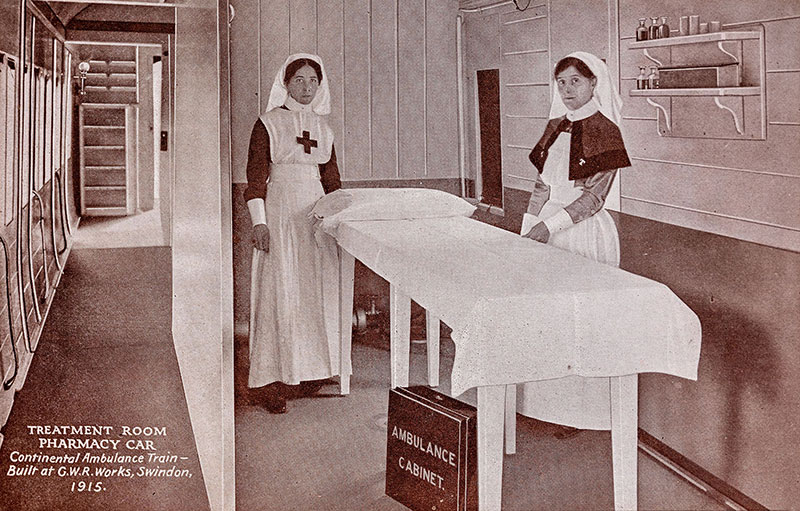
Interior of Ambulance Train No 18, illustrated in a GWR official postcard in the Great Western Trust collection
Among the helpless patients and among the shell shock patients there was considerable alarm, which was increased as loud explosions began to be heard.
The firing continued and the explosions crept nearer, until, for us, the climax was reached when at short intervals 5 bombs fell in our immediate neighbourhood, near enough to send debris over the train. Twice the lamps were blown out; windows were broken on both sides of the train. The nearest bomb tore up the off rail of the line next to us, smashed the windows and rocked the coach so much that the patients on one side were thrown out of their cots. The attack lasted an hour.

Interior of Ambulance Train No 18, illustrated in a GWR official postcard in the Great Western Trust collection
The sisters rose to the occasion from the very beginning. Carrying hand lamps they went about their jobs coolly, collectedly and cheerfully. Their influence in stopping panic and allaying alarm, was I believe, greater than that of the officers – just because they were sisters – patients and personnel felt they had to play up to the standard they set. They had their chance and rose to it magnificently.
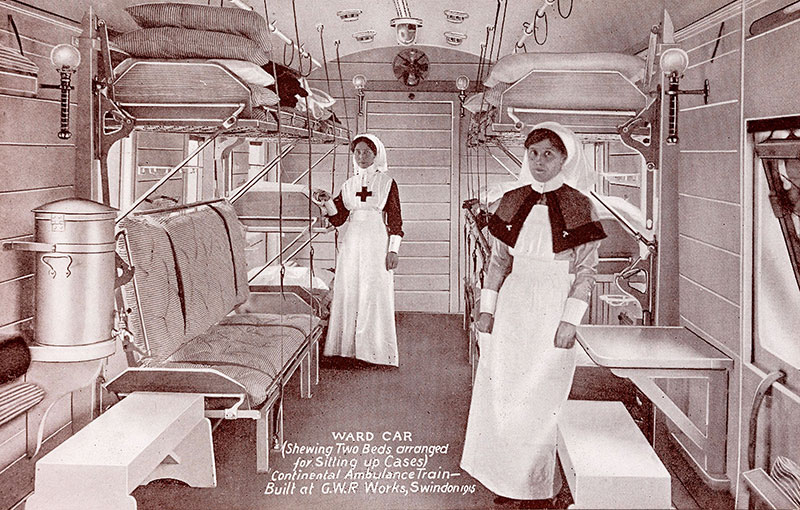
Interior of Ambulance Train No 18, illustrated in a GWR official postcard in the Great Western Trust collection. It shows F W Marillier’s three-tier bunk system, with two of the lower bunks arranged for sitting cases
The GWR supplied its first two Ambulance Trains very soon after the start of the Great War, leaving Swindon Works on 24 and 25 August 1914 for Southampton. They were used in the UK to transport wounded from ports of entry to hospitals. The ward cars were adapted from passenger brake vans.
In early 1915 the GWR supplied its first two nine-vehicle Ambulance Trains for use on the Continent, and a third later that year of seven vehicles (Toplight brake thirds) for home use, funded by the United Kingdom Flour Millers. These first trains were painted in the full lined-out GWR livery with crests.
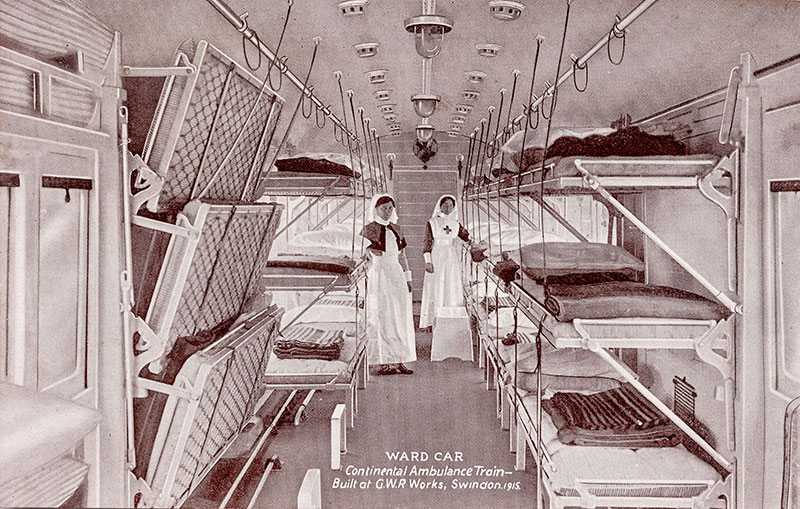
Interior of Ambulance Train No 18, illustrated in a GWR official postcard in the Great Western Trust collection. It shows F W Marillier’s three-tier bunk system
Also in 1915, the Railway Executive Committee (REC) set up a sub-committee to draw up plans to convert and design new ambulance trains. Ambulance Train No 18, of sixteen coaches, was constructed at Swindon to this design and exhibited at Paddington from 25 to 27 August 1915. The later trains did not have GWR livery, and didn’t show their origins.
The GWR’s Carriage Manager at Swindon, F W Marillier, was on the committee. He designed the folding three-tier bunk system on both sides of the coach which helped to maximise the capacity of the ambulance trains for both lying-down and sitting casualties: the top bunk was used for lying-down patients and the other two for lying-down or sitting cases. He was awarded the OBE in 1918 and the CBE in 1920 for his efforts.

A photograph from the Imperial War Museum archive, taken behind the lines at the Battle of the Somme showing nurses arriving at an ambulance train at Dernancourt in September 1916, see: http://www.iwm.org.uk/collections/item/object/205072619 The train is one of those supplied by the GWR
In 1918 the GWR provided to Ambulance Trains for use of the US army. The trains were painted khaki green outside, and lettered at the ends US 54 and US 55 respectively. Two red crosses were marked on each of the vehicles towards the ends, and in the centre were the letters US in white and red.
The government reimbursed the railway companies for the actual cost of coaches supplied for the Ambulance Trains, plus costs of conversion and transport to their destination.

One of the coaches in the Ambulance Trains supplied by the GWR to the US army in 1918. Photograph published in the Great Western Railway Magazine, April 1918
TUESDAY 16 JANUARY
On 15 January 1898, the Countess of Morley opened the Great Western Railway’s new 6½ mile line from Plymstock to Yealmpton in Devon. There were four intermediate stations on the line: Billacombe, Elburton Cross, Brixton Road, and Steer Point. A special first-class saloon train hauled by a locomotive named Lady Morley for the occasion took the GWR deputy Chairman and guests from Plymouth Millbay to Yealmpton. There was a public holiday on the day in Yealmpton and the goods shed there was decorated with flags, bunting and flowers to serve as a dining room for a celebration champagne lunch.

A steam railmotor and trailer at Steer Point station in 1928. Photograph in the Jeffery collection, Great Western Trust
The branch was notable in being cut off from the rest of the GWR, access being gained with running powers over the London & South Western Railway between Cattewater and Plymstock, a distance of around half a mile.
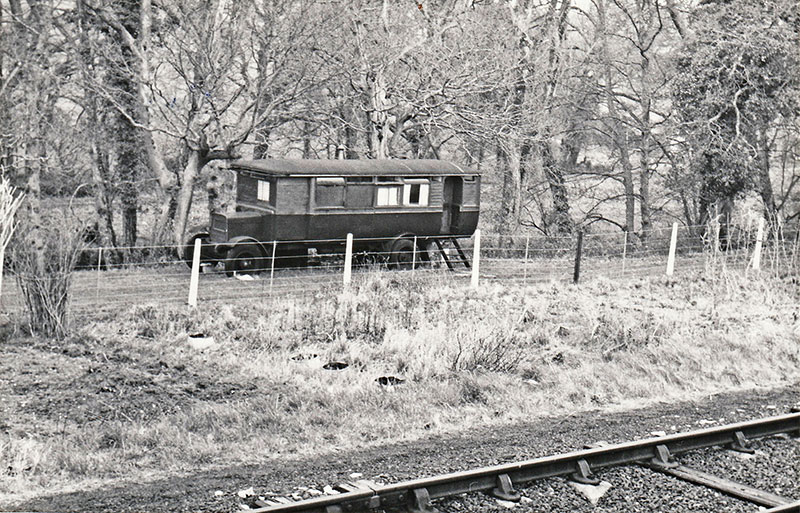
An early bus converted into a caravan at Yealmpton, photographed on 17 March 1952 by Hugh Davies
The initial modest service of four weekday trains each way was much criticised by locals. It increased in time with railmotors running seven trains a day and increased again to nine a day with auto-trains. A Modbury, Yealmpton and Plymouth bus service started in 1904 and had reached a height by 1926 with up to ten buses a day. By 1928 the line was loss-making and the passenger service ceased in July 1930 due to competition and was replaced by a bus service. Goods services continued with a daily freight service through the 1930s. One of the local buses later found use as a caravan.
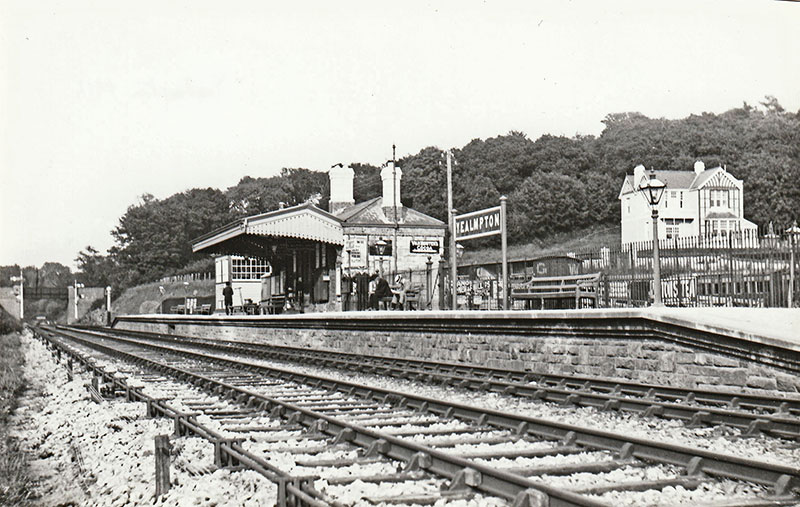
Yealmpton station in 1913. Photograph in the Jeffery collection, Great Western Trust
During the Second World War, after a week’s closure from bomb damage in March 1941 the passenger service was re-instated firstly with unadvertised workmen’s trains in July 1941 and then from Plymouth Friary station the following November. This was to help cope with the numbers of people in the area evacuated from Plymouth due to heavy bombing. However, passenger services ceased again on 4 October 1947. Freight only services and a few enthusiasts’ specials continued, with the last being a Plymouth Railway Circle special on 27 February 1960, after which complete closure occurred, and the track was lifted in late 1962.
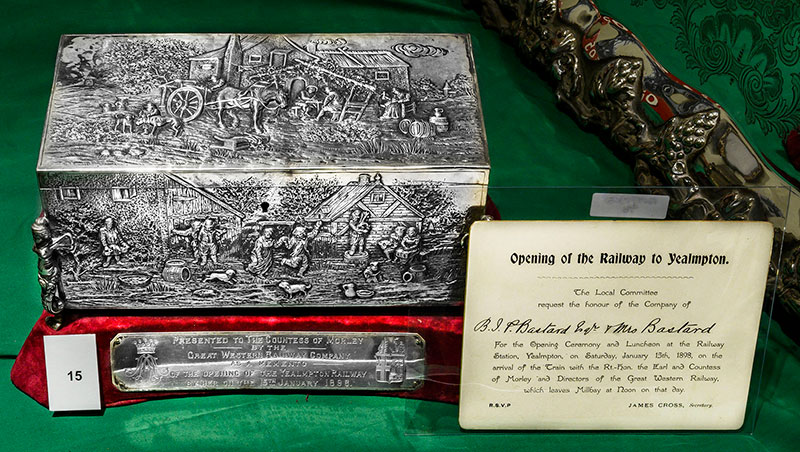
The silver casket presented to Lady Morley by the GWR after she performed the opening ceremony for the Yealmpton Railway, and an invitation card to the ceremony. Both items in the Great Western Trust collection
This week’s Tuesday Treasure harks back to 1898 and the opening ceremony. The Great Western Trust is fortunate to possess the silver casket presented by the GWR to the Countess of Morley on the day together with an invitation card to the opening event. The casket originally contained views of that part of the county from pictures by local artists, according to a newspaper report.
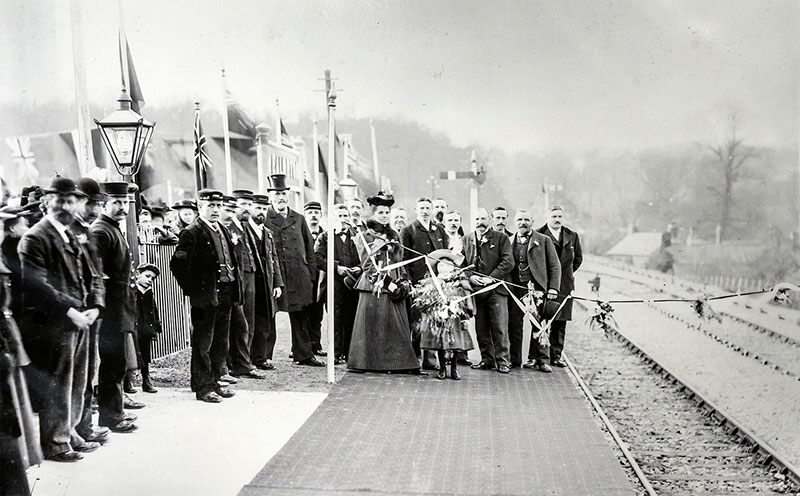
The opening ceremony on 15 January 1898, photograph in the Great Western Trust collection
TUESDAY 9 JANUARY
Football Crazy
Happy New Year to our followers!
In our previous Tuesday Treasures Blogs in late 2020, we described the BRWR ‘Radio Train’ which in January 1960 was advertised to carry Aston Villa Football Club supporters to an away match at Swansea and then in June 2021 we covered the England v Brazil match in 1956.
Well with it being a strong tradition around Christmas and New Year to hold Football matches, we start 2024 looking back at this handbill from our Great Western Trust collection, published in January 1909 for Bristol City v Southampton in the ‘English Cup 1st Round (Competition Proper)..’
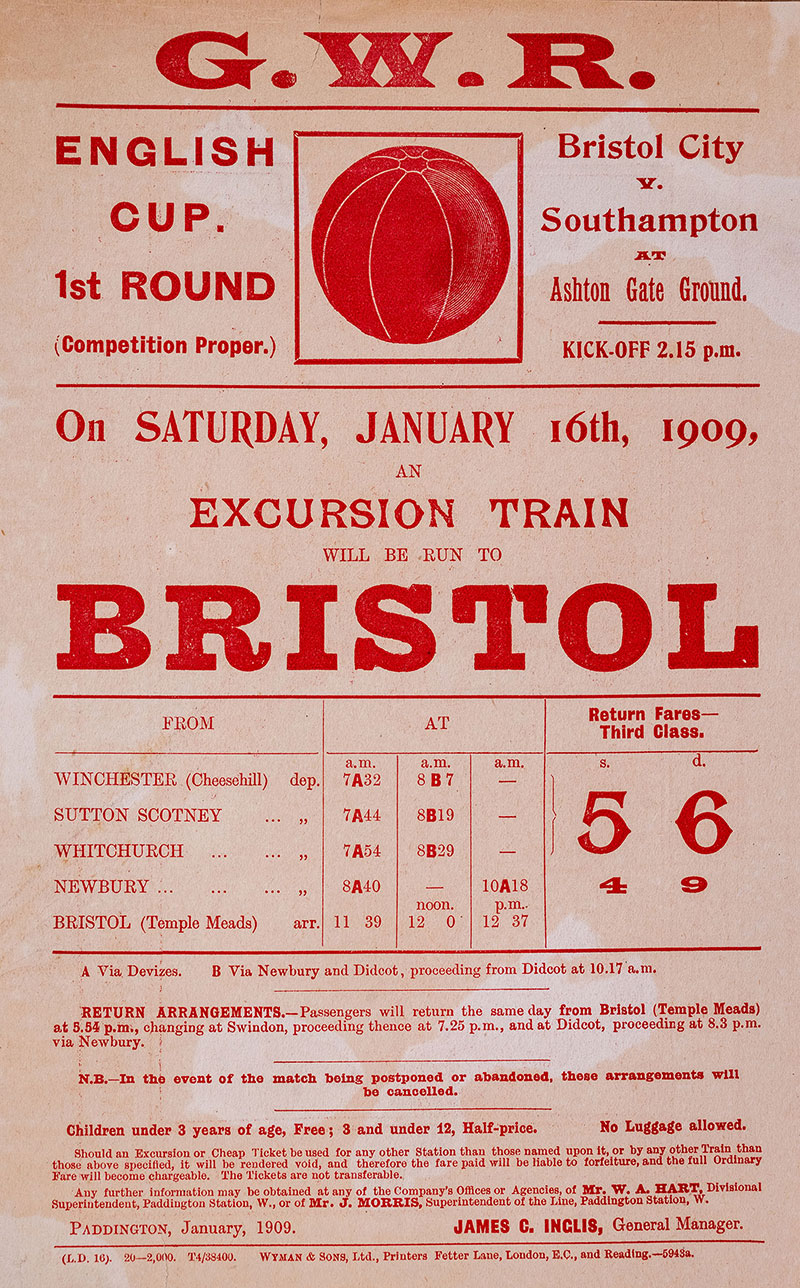
The handbill in the Great Western Trust collection advertising travel via the Didcot, Newbury and Southampton line to the 16 January 1909 match
Clearly interest was expected from folk on the Didcot, Newbury & Southampton line stations, although quite how many children aged 3 to 12 years attended is doubtful even if they travelled half price, or even free if younger!
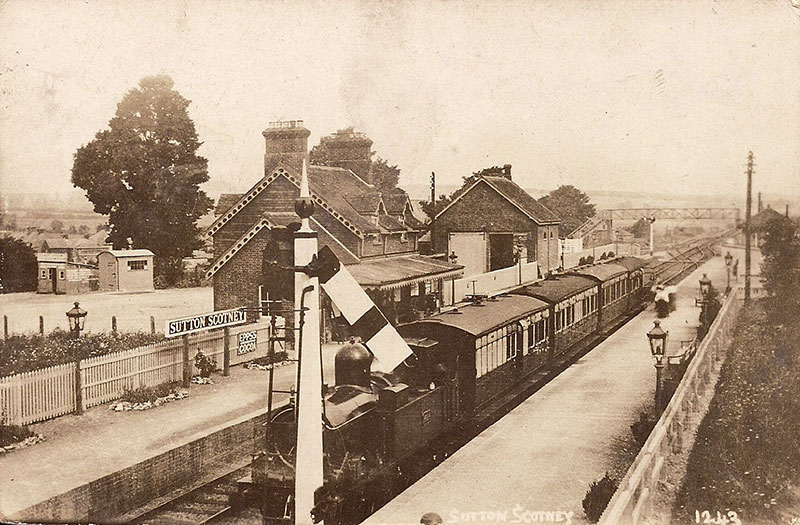
Sutton Scotney railway station in an old postcard
The standard publicity of the GWR in that era meant that the rear of the handbill advertised the ‘New Fishguard Route to Ireland’ which had cost the Great Western Railway a fortune to create, so every opportunity to mention it was keenly taken. That said however, would football supporters who were dominated by working class men, have been able to seriously invest in such a holiday to Ireland? The Trust Collection has GWR pictorial posters for such Irish attractions, clearly aimed at the gentrified classes!
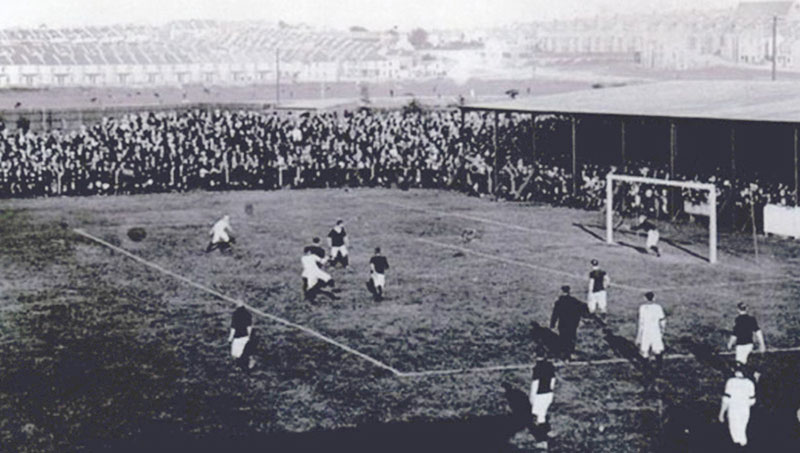
A football match at Ashton Gate during the Edwardian era. Credit Bristol City
The match on 16 January 1909 ended in a 1-1 draw. Bristol City won the replay at Southampton, and in subsequent rounds beat Bury, Norwich City, Glossop North End and Derby County.
That took them to the Cup Final against Manchester United at Crystal Palace on 24 April 1909. The Great Western Trust collection also includes a handbill advertising excursion tickets to London for this match. As an alternative the same day, Queen’s Park Rangers were playing Croydon Common at Park Royal!

The handbill in the Great Western Trust collection advertising travel from London Division stations to the 1909 Cup Final
At the Cup Final, Manchester United won 1-0, the first time the club had won the FA Cup, and it was also the last time Bristol City made it to the Final.
It must not be forgotten that Manchester United had railway origins, being founded in 1878 at the Newton Heath carriage and wagon works of the Lancashire and Yorkshire Railway. It was known as Newton Heath LYR Football Club, adopting its current name in 1902.
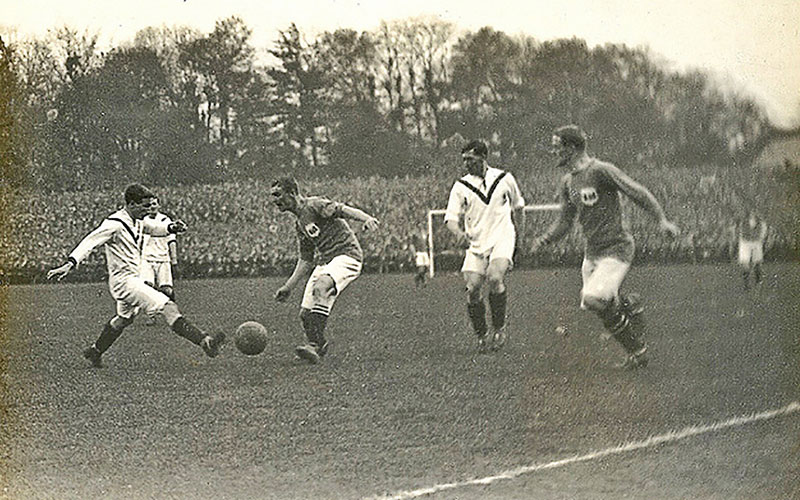
The 1909 Cup Final in progress. Manchester United played in white shirts with a red V. Image: Creative Commons
Didcot Railway Centre Newsletter
Stay up to date with events and what's going on at Didcot Railway Centre.
You may unsubscribe at any time. We do not share your data with 3rd parties.